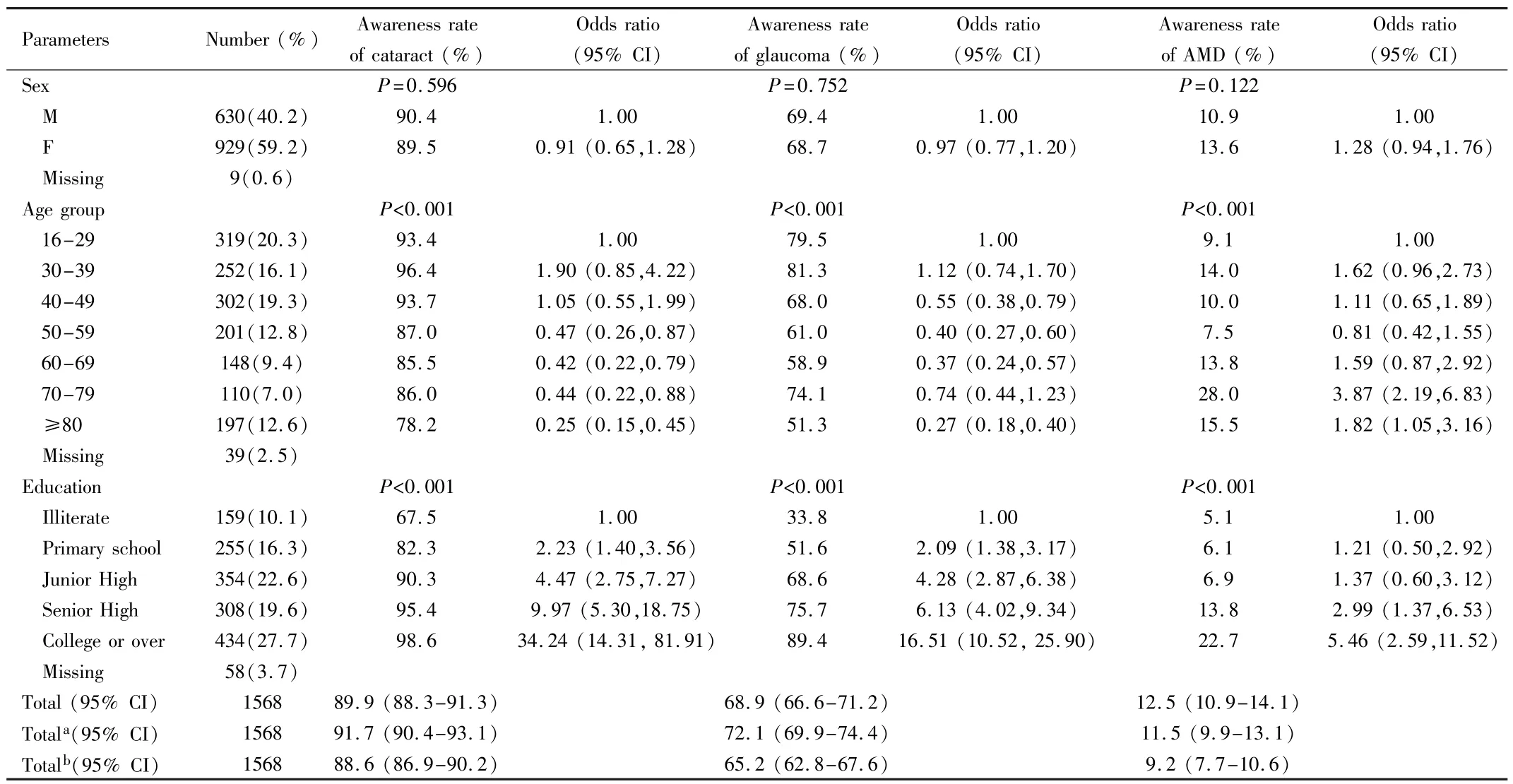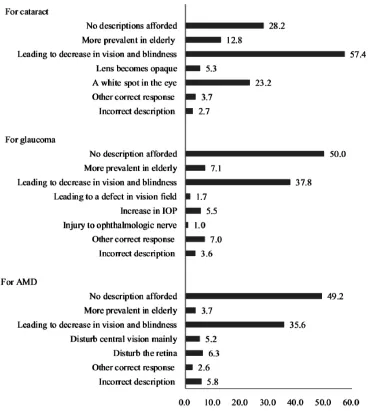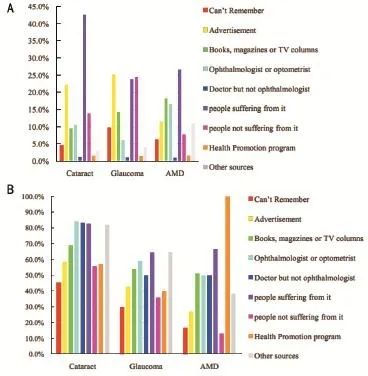Awareness and knowledge about cataract,glaucoma,and age-related macular degeneration in Chengdu,China
2016-11-16BingZhangJingGeGaoChengPanMeiLuanXiaoMingChen
Bing Zhang,Jing-Ge Gao,Cheng Pan,Mei Luan,Xiao-Ming Chen
Awareness and knowledge about cataract,glaucoma,and age-related macular degeneration in Chengdu,China
Bing Zhang1,2,Jing-Ge Gao2,Cheng Pan2,Mei Luan2,Xiao-Ming Chen1
1DepartmentofOphthalmology,WestChinaHospital,Sichuan University,Chengdu 610041,Sichuan Province,China
2WestChinaSchoolofMedicine,SichuanUniversity,Chengdu 610041,Sichuan Province,China
Correspondence to:Xiao-Ming Chen.West China Hospital,Sichuan University,No.37GuoXueXiang,Chengdu 610041,Sichuan Province,China.chenxm58@163.com
目的:调查成都市白内障、青光眼及年龄相关黄斑变性(age-related macular degeneration,AMD)知晓率、知识水平及自报患病率情况。
方法:本研究首先设计了一份关于白内障、青光眼及AMD知晓率及知识水平的结构化问卷,随后使用该问卷在成都市随机选择6个养老机构和四川大学华西医院非眼科门诊患者中进行了调查。本研究采用卡方检验分析各因素对于知晓率及知识水平的影响,并检验其他研究结果与本研究的差异。
结果:在所有调查对象中,白内障、青光眼及AMD的知晓率分别为89.9%,68.9%和12.5%;在知晓相应疾病的人群中,具有一定知识水平的比例分别为70.9%,48.1%和44.9%;教育程度影响三种眼病的知晓率,信息来源影响三种眼病的知识水平。白内障、青光眼及AMD的自报患病所占比例分别为7.8%,1.1%和0.6%,40岁以上调查对象中分别为12.5%,1.6%和1.0%。在所有调查对象中,进行过视力测试、眼压测量及眼底检查的比例分别为72.1%,17.9%和20.2%。
结论:首次根据本研究在中国大陆地区报道的相关数据,提高白内障、青光眼及AMD(尤其是后两者)知晓率及知识水平十分必要。同时,即便没有任何眼病史,我们也建议人们进行定期眼科检查。
引用:张冰,高静歌,潘成,栾梅,陈晓明.成都市白内障、青光眼及年龄相关性黄斑变性知晓率及知识水平调查.国际眼科杂志2016;16(3):397-402
·AIM:To investigate the awareness,knowledge and selfreported prevalence about the cataract,glaucoma and agerelated macular degeneration(AMD)in Chengdu,China.
·METHODS:Astructuredquestionnairewasfirst designedontheawarenessandknowledgeofthe cataract,glaucoma,and AMD.The survey was then conducted in 6 randomly selected nursing homes from Chengdu and in outpatient clinics of non-ophthalmologic departmentsofWestChinaHospitalwiththe questionnaire.Chi-square test was applied to determine a certain factor's impact on the awareness or knowledge rates and to determine the difference between awareness rates in our research and others'studies.
·RESULTS:Of the participants,the awareness rates of the cataract,glaucoma and AMD were 89.9%,68.9%and 12.5%respectively.Among the people aware of each disease,the knowledge rates of the cataract,glaucoma and AMD were 70.9%,48.1%and 44.9%.Educational level was a factor affecting awareness rates of all three diseases;information source was a factor affecting the knowledge rates of each ocular disease.The self-reported prevalence of the cataract,glaucoma and AMD were 7.8%,1.1%,0.6%in all participants,and 12.5%,1.6%,1.0%in the participants over 40.The proportions of the participants having taken the visual acuity test,intraocular pressure examination,andfundusexaminationwere 72.1%,17.9%,and 20.2%.
·CONCLUSION:According to the data firstly reported in mainland China in our study,it is necessary to improve people'sawarenessandknowledgeofthecataract,glaucoma,andAMD,especiallythelattertwo. Meanwhile,wesuggestpeopletakingregular ophthalmologic examinations even without a history of eye diseases.
awareness;knowledge;glaucoma;cataract;age-relatedmaculardegeneration;self-reported prevalence
INTRODUCTION
I n 2010,there were about 39.37 million blind and 246.02 million low vision people globally;in China, there were 8.25 million blind people and 67.26 million with low vision,comprising more than 1/5 of the corresponding patient population worldwide[1].Globally,the three leading causes of blindness are cataracts,glaucoma and age-related macular degeneration;these diseases accounted for 51%,8%,and 5%of all blindness respectively[1].In China,the rate of the blindness associated with these three diseases was reported 54%in Beijing,66%in Hong Kong,less than 85% in Nantong[2-4].
Amongthethreediseases,cataractandglaucomaare preventable.Early diagnosis and intervention not only save patients a large sum of money and reduce the burden of public health,butalsoimprovespatients'qualityoflife[5-7]. Although there are no effective treatments for age-related macular degeneration(AMD),avoidance of certain risk factors,such as cigarette smoking,may postpone its onset and slow its progression[8-9].
Awareness is defined as whether a person has heard some information.The lack of awareness about ophthalmopathies is associated with poorer prevention and treatment[10].Studies in different countries have reported a low level of awareness of these eye diseases,especially glaucoma and AMD[11-15],although eye care is usually readily accessible[15].However,to our knowledge,no similar study has been carried out in mainland China,where the blind comprise approximately 1/5 of the corresponding global population.More specifically,around 4 to 7 million cases of blindness in China are caused by the three vision-killers[1-4].Therefore,we conducted this cross-sectionalstudyofnursinghomeandoutpatient populations in Chengdu(a city in southwestern China)between July 1st,2014 and Oct.1st,2014,to determine the level of awareness and knowledge of the cataract,glaucoma,and AMD.We also surveyed the self-reported prevalence of the ocular diseases at the same time.
SUBJECTS AND METHODS
A structured questionnaire was designed based on former studies[8,11,14],consisting of three different sections.The demographicsectionwasmadeupofsex,age,and educational level.The history section contained the selfreportedpastandcurrentoculardiseasesandthe ophthalmologic examinations that a participant having been taken[visual acuity(VA)test,intraocular pressure(IOP),and fundus examination].The third section focused on awareness,information sources,and knowledge.We defined awareness of a certain eye disease as a respondent having heard of its name[11].We defined knowledge of a disease as a respondent being able to state facts that matched the disease description in our questionnaire or were approved by an ophthalmologist[16].All information given by a respondent was recorded on the questionnaire during the investigation.This study was conducted in accordance withDeclarationof Helsinki and oral informed consent was obtained from every participant.No participant received a stipend from this study. We aimed to investigate people aged 16y old or over,with normal cognitive ability,who agreed to participate in the survey after being informed of its purpose.
We calculated a sample size N≥1305,given the formula of the sample size of cross-sectional study,p=12(12%was the awareness rate of AMD in pre-survey,which was the lowest one among three ocular diseases),q=88(q= 100-p)and d=1.8(relative precision set at 15%).The first stage of the survey was carried out on nursing home population in Chengdu.Six of nine areas of Chengdu were selected out by random number generated by the R software. For each area,one of the registered nursing homes was also selected out by random number generated by the R software. All residents who met our inclusion criteria in each nursing home were invited to join in the survey.The second stage of the survey was conducted on non-ophthalmologic outpatients in West China Hospital.We invited the outpatients who met our inclusion criteria to participate in the survey.During the survey,all respondents were free to withdraw it and refuse to answer any question.
Statistical Analysis We applied Chi-square test to determine a factor's impact on awareness or knowledge and to determine the difference between awareness rates in our investigation and those in other studies.We also applied covarianceanalysistodetermineafactor'simpacton awareness while controlling others as fixed ones.Odds ratios and its 95%confidence interval(CI)were calculated with its formula in Excel,and all other analyses were finished with R Software(Version 3.1.3).All P value are in two-tail and all significance was defined as P<0.05.We included questionnaires with missing items and all missing items were left blank in analysis.
RESULTS
From July 1stto Oct.1st,2014,1581 out of 1865 invited people agreed to participate in the survey(responding rate 84.8%),13 were excluded with an age<16y old,leaving 1568 aged 16-100 for analysis(84.1%),including 1267 non-ophthalmologicoutpatientsand 301nursinghome residents.Demographic statistics on sex,age groups,and education levels are given in Table 1.
Awareness on Three Eye Diseases The awareness rates of each ocular disease and corresponding rates adjusted by standard age groups and standard educational backgrounds were available in Table 1.The adjustments were done withdata from Chinese sixth nationwide population census in 2010. Age group and education level,but not sex affected the awareness of all three eye diseases after Chi-square analysis. The awareness was higher in people with a better education level.However,age group was no more an influencing factor in theawarenessratesofcataractandglaucomaafter controlling education level as a fixed factor.As for the AMD,awareness rate was significantly higher in people between 70 and 79(28.0%)and lower in other age groups(<16%)even after controlling education level as a fixed factor. However,we cannot explain this.As shown in Table 2,our resultsaresignificantlydifferentfromthoseinformer studies[8,11-15,17-19](P values not listed).

Table 1 Demographic information and awareness rates of three ocular diseases

Table 2 Awareness rates of cataract,glaucoma and AMD in different countries and areas
Knowledge on Three Eye Diseases As shown in Figure 1,70.9%of the cataract-aware participants were knowledgeable about the disease.The most common two correct descriptions of the cataract were‘leading to a decrease in vision and blindness'(57.4%)and‘awhitespotintheeye'(23.2%).Only a few knew the mechanism of it,or‘the lens becomes opaque'(5.3%).Less than 50%of the glaucoma-aware respondents were knowledgeable about the disease,given that 50.0%couldn't give any description and 3.6%made an incorrect statement.The most common correct description of glaucoma was also the disease‘leading to a decrease in vision and blindness'(37.8%).Only a few knew the disease‘with an increase in intraocular pressure(IOP)'(5.5%),‘leading to a defect in vision field'(1.7%),‘injuring to the ophthalmologic nerve'(1.0%).As for AMD-aware participants,49.2%gave no description and 5.8% made an incorrect statement,leaving less than 50%answered correctly.The most common correct answer remained the disease‘leading to a decrease in vision and blindness'(35.6%).Only 5.2%of those aware of the AMD knew the disease would‘disturb central vision mainly'and 6.3%knew it‘disturb the retina'.
As shown in Figure 2,the most common three ways that respondents got aware of the cataract and glaucoma were from‘people who suffering from it',‘people not suffering from it' and‘advertisement'.The most common three information sources for AMD were from‘people who suffering from it',‘books,magazines,or TV columns',and‘ophthalmologist or optometrist'.
Self-Reported Prevalence of Three Ocular Diseases and Conditions of Ophthalmologic Examinations The selfreported and the corresponding age adjusted prevalence of the cataract,glaucoma and AMD in all respondents and in people over 40 was shown in Table 3.The self-reported prevalence of glaucoma over 50 was 2.3%(95%CI,1.1-3.4%)and age adjusted value was 1.4%(95%CI,0.5-2.3%).The percentages of the participants having taken the VA,IOP,or fundus examination were 72.1%(95%CI,69.8-74.3%),17.9%(95%CI,16.0-19.8%),and 20.2%(95%CI,18.2-22.2%).Moreover,in participants who reported no ophthalmologic disease now or before,the corresponding rates were significantly lower,or 60.7%(95%CI,56.9-64.6%)for the VA,8.6%(95%CI,6.4-10.8%)for the IOP,and 8.6%(95%CI,6.4-10.8%)for the fundus examination.

Table 3 Self-reported prevalence of three ocular diseases

Figure 1 Descriptions given by the participants aware of different ocular diseases(%),one could give several correct descriptions of an ocular disease.

Figure 2 Proportions(A)and knowledge rates(B)of the participants of different information sources,one could get aware of a disease from several information sources.
DISCUSSION
To our knowledge,this is the first study to investigate awareness and knowledge of the cataract,glaucoma,and AMD in mainland China.In our study,awareness rates and knowledge rates were low in the glaucoma and AMD,and relatively high in the cataract.The education level was a factor affecting awareness of all three ocular diseases and the information source was a factor affecting the knowledge rates.As shown in Table 2,the awareness rates of the cataract and glaucoma in our study were significantly lower than those in studies done in Hong Kong and Australia and higher than those done in Iran,India and Nepal.As for the glaucoma,the rate was also lower than those in studies done in the USA andGermanandhigherthantheawarenessratesin Switzerland and Ethiopia.The awareness rate of the AMD was higher than those in studies done in Hong Kong and Australia. Possible reasons for these differences may be the various education levels,economic development levels and health service levels in the countries and area.
The knowledge rate of cataract was relatively high,but the knowledge rates for glaucoma and AMD were low,and both were less than 50%in the participants aware of each disease. Moreover,most of the disease-aware respondents knew just some symptoms of each ocular disease.The most common correct knowledge of all three ocular diseases was that they could‘lead to a decrease in vision and to blindness'.Only a low percentage knew the mechanisms of each ophthalmologic disease.For example,the number of the participants who knew the cataract was a disease with opaque lens was less than the number of the self-reported patients of it.In other word,some patients didn't know the mechanism of a certain ocular disease even after being diagnosed.
As shown in Figure 2,different sources that a respondent heard an ocular disease from affected the knowledge rate of that disease.Participants that couldn't remember how they heardadiseasehadalowknowledgerate.Though advertisement was a popular information source,among the respondents that learnt a disease from advertisement,the knowledge rate was low.If respondents heard a disease from people who didn't suffer it,the knowledge rate was also low. However,if respondents learnt a disease from those who suffered it,they had a high knowledge rate.Meanwhile,participants had a high knowledge rate when they learnt an ocular disease from the‘ophthalmologist or optometrist',‘doctor but not ophthalmologist'or‘books,magazines or TV columns'.
In former studies done in Chinese community,after being examined and diagnosed by ophthalmologists,the prevalence of cataract and AMD over 40 was 24.7%[20]and 1.7%[21];the prevalence of glaucoma over 50 was 3.8%[22].All of the rates were significantly higher than the corresponding selfreported prevalence in our study.A possible explanation might be that the undiagnosed rates of these diseases were high and perhaps over 50%for each disease based on a rough estimationwithourdata.Alackofophthalmologic examination,especially the IOP and fundus examination,may be a cause for the low self-reported prevalence of each ocular disease.
Several limitations must be considered in interpreting our findings.Limited by the lack of funding,our sample consisted of randomly selected nursing home residents in Chengdu and nonrandomly selected outpatients in West China Hospital(We investigated the outpatients as it was easy to get a large sample and the nursing home population as the prevalence of each ocular diseases was high in them thus it was able to get more accurateself-reportedprevalence).Therefore,our investigation was a nonrandom cross-sectional study overall. Meanwhile,as a monocentric investigation,most of our participants were from Chengdu or area nearby and most of them were outpatients of our hospital,both a selective bias and an admission bias may exist in our study;our sample may not well represent the Chinese population.We did some adjustment according to the standard age group and standard education background to revise these biases.
In summary,to decrease blindness and vision impairments,it is necessary to improve people's awareness and knowledge of vision-killer diseases such as the cataract,glaucoma,and AMD.Firstly,it's a slow but vital way to improve people's education level.Secondly,it's an effective approach to encourage patients,ophthalmologists and other doctors to educate the other people.Thirdly,more books,magazines,and TV programs on the ocular diseases,especially on the mechanism of each disease are also needed.As many ocular patients are not diagnosed and a lack of ophthalmologic examination could be a reason,we suggest people,even without any symptoms,to take regular eye examinations.
REFERENCES
1 Pascolini D,Mariotti SP.Global estimates of visual impairment:2010. Br J Ophthalmol 2012;96(5):614-618
2 Jonas JB,Xu L,Wang YX.The Beijing Eye Study.Acta Ophthalmol 2009;87(3):247-261
3 Li L,Guan H,Xun P,Zhou J,Gu H.Prevalence and causes of visual impairment among the elderly in Nantong,China.Eye(Lond)2008;22(8):1069-1075
4 Michon JJ,Lau J,Chan WS,Ellwein LB.Prevalence of visual impairment,blindness,and cataract surgery in the Hong Kong elderly. Br J Ophthalmol 2002;86(2):133-139
5 Lorenz K,Wolfram C,Breitscheidel L,Shlaen M,Verboven Y,Pfeiffer N.Direct cost and predictive factors for treatment in patients with ocular hypertension or early,moderate and advanced primary open-angle glaucoma:theCoGISstudyinGermany.GraefesArchClinExp Ophthalmol 2013;251(8):2019-2028
6 Lansingh VC,Carter MJ,Martens M.Global cost-effectiveness of cataract surgery.Ophthalmology 2007;114(9):1670-1678
7 Rein DB,Wittenborn JS,Lee PP,Wirth KE,Sorensen SW,Hoerger TJ,Saaddine JB.The cost-effectiveness of routine office-based identification and subsequent medical treatment of primary open-angle glaucoma in the United States.Ophthalmology 2009;116(5):823-832
8 Lau JT,Lee V,Fan D,Lau M,Michon J.Knowledge about cataract,glaucoma,and age related macular degeneration in the Hong Kong Chinese population.Br J Ophthalmol 2002;86(10):1080-1084
9 Myers CE,Klein BE,Gangnon R,Sivakumaran TA,Iyengar SK,Klein R.Cigarette smoking and the natural history of age-related macular degeneration:the Beaver Dam Eye Study.Ophthalmology 2014;121(10):1949-1955
10 Huang OS,Zheng Y,Tay WT,Chiang PP,Lamoureux EL,Wong TY.Lack of awareness of common eye conditions in the community. Ophthalmic Epidemiol 2013;20(1):52-60
11 Dandona R,Dandona L,John RK,McCarty CA,Rao GN. Awareness of eye diseases in an urban population in southern India.Bull World Health Organ 2001;79(2):96-102
12 Thapa SS,Berg RV,Khanal S,Paudyal I,Pandey P,Maharjan N,Twyana SN,Paudyal G,Gurung R,Ruit S,Rens GH.Prevalence of visual impairment,cataract surgery and awareness of cataract and glaucoma in Bhaktapur district of Nepal:the Bhaktapur Glaucoma Study. BMC Ophthalmol 2011;11:2
13 Mansouri K,Orgul S,Meier-Gibbons F,Mermoud A.Awareness about glaucoma and related eye health attitudes in Switzerland:a survey of the general public.Ophthalmologica 2006;220(2):101-108
14 Michielutte R,Diseker RA,Stafford CL,Carr P.Awareness about glaucoma and related eye health attitudes in Switzerland:a survey of the general public.J Community Health 1984;9(4):269-284
15 Livingston PM,McCarty CA,Taylor HR.Knowledge,attitudes,and self care practices associated with age related eye disease in Australia.Br J Ophthalmol 1998;82(7):780-785
16 Ediau M,Babirye JN,Tumwesigye NM,Matovu JKB,Machingaidze S,Okui O,Wanyenze RK,Waiswa P.Community knowledge and perceptions about indoor residual spraying for malaria prevention in Soroti district,Uganda:a cross-sectional study.Malar J 2013;12:170
17 Katibeh M,Ziaei H,Panah E,Moein HR,Hosseini S,Kalantarion M,Eskandari A,Yaseri M.Knowledge and awareness of age related eye diseases:a population-based survey.J Ophthalmic Vis Res 2014;9(2): 223-231
18 Pfeiffer N,Krieglstein GK,Wellek S.Knowledge about glaucoma in the unselected population:a German survey.J Glaucoma 2002;11(5): 458-463
19 Tenkir A,Solomon B,Deribew A.Glaucoma awareness among people attending ophthalmic outreach services in Southwestern Ethiopia.BMC Ophthalmol 2010;10:17
20 Duan XR,Liang YB,Wang NL,Wong TY,Sun LP,Yang XH,Tao QS,Yuan RZ,Friedman DS.Prevalence and associations of cataract in a rural Chinese adult population:the Handan Eye Study.Graefes Arch Clin Exp Ophthalmol 2013;251(1):203-212
21 Xu L,Li Y,Zheng Y,Jonas JB.Associated factors for age related maculopathy in the adult population in China:the Beijing eye study.Br J Ophthalmol 2006;90(9):1087-1090
22 He M,Foster PJ,Ge J,Huang W,Zheng Y,Friedman DS,Lee PS,Khaw PT.Prevalence and clinical characteristics of glaucoma in adult Chinese:a population-based study in Liwan District,Guangzhou.Invest Ophthalmol Vis Sci 2006;47(7):2782-2788
成都市白内障和青光眼及年龄相关性黄斑变性知晓率及知识水平调查
张 冰1,2,高静歌2,潘 成2,栾 梅2,陈晓明1
国家自然科学基金(No.81270993)
(1610041中国四川省成都市,四川大学华西医院眼科;2610041中国四川省成都市,四川大学华西临床医学院)
张冰,就读于四川大学华西临床医学院,八年制临床医学博士研究生,研究方向:临床眼科学、青光眼。
陈晓明,毕业于四川医学院,博士,教授,博士生导师,研究方向:青光眼.chenxm58@163.com
知晓率;青光眼;白内障;年龄相关性黄斑变性;自报患病率
10.3980/j.issn.1672-5123.2016.3.01
Zhang B,Gao JG,Pan C,Luan M,Chen XM. Awareness and knowledge about cataract,glaucoma,and agerelated macular degeneration in Chengdu,China.Guoji Yanke Zazhi(Int Eye Sci)2016;16(3):397-402
National Natural Science Foundation of China(No.81270993)
2015-07-05 Accepted:2015-08-21
猜你喜欢
杂志排行
国际眼科杂志的其它文章
- Work-related ocular injuries in Johor Bahru,Malaysia
- 个性化人工晶状体选择方案治疗年龄相关性白内障的临床研究
- BMP-2在C57BL/6小鼠形觉剥夺性近视眼巩膜中表达的变化
- Glaucomatous changes in macular ganglion cell detected byspectraldomainopticalcoherencetomography: comparison with peripapillary retinal nerve fiber layer
- 玻璃酸钠滴眼液治疗青少年近视患者配戴硬性透气性角膜接触镜相关性干眼
- PSP对STZ诱导的糖尿病大鼠眼保护作用的临床动态观察
